
American Base Hospital No. 36 was an American military hospital formed in Detroit, Michigan. During the First World War, the hospital moved to Vittel in northeastern France where it was set up to deal with war casualties.

American Base Hospital No. 36 was an American military hospital formed in Detroit, Michigan. During the First World War, the hospital moved to Vittel in northeastern France where it was set up to deal with war casualties.

Base Hospital No. 36 was organized in April, 1917, at the Detroit College of Medicine, and was mobilized at Detroit, August 23, 1917. The unit remained in training there for two months and sailed from New York City on the SS Orduña, October 27, 1917, arriving in France on November 11, 1917, and at Vittel, its permanent station, on November 17. [1]
It was the first unit to arrive at Vittel, later forming a part of the Vittel-Contrexéville hospital center. It occupied 16 hotels and villas and had a total bed capacity of 1,650. The first patients were received December 8, 1917. During its activity, December 8, 1917, to January 14, 1919, the hospital cared for 14,114 medical and surgical cases, of which 1,376 were allied sick and wounded. [1]
On January 14, 1919, all remaining patients were evacuated and the hospital ceased to function. The unit sailed from Saint-Nazaire, April 13, 1919, on the USS Rijndam, arriving at Newport News, Virginia, April 25, 1919, and was demobilized at Camp Custer, Kalamazoo County, Michigan, May 4, 1919. [1] [lower-alpha 1]

Commanding Officer
Chief of Surgical Service
Chief of Medical Service
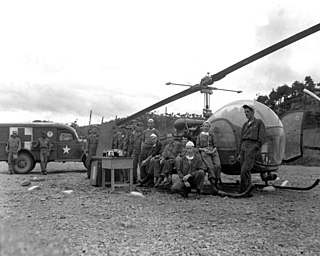
Mobile Army Surgical Hospitals (MASH) were U.S. Army field hospital units conceptualized in 1946 as replacements for the obsolete World War II-era Auxiliary Surgical Group hospital units. MASH units were in operation from the Korean War to the Gulf War before being phased out in the early 2000s. Each MASH unit had 60 beds, as well as surgical, nursing, and other enlisted and officer staff available at all times. MASH units filled a vital role in military medicine by providing support to army units upwards of 10,000 to 20,000 soldiers. These units had a low mortality rate compared to others, as the transportation time to hospitals was shorter, resulting in fewer patients dying within the "Golden Hour", the first hour after an injury is first sustained, which is referred to in trauma as the "most important hour". The U.S. Army deactivated the last MASH unit on February 16, 2006, and the successors to Mobile Army Surgical Hospitals are combat support hospitals.

The 76th Infantry Division was a unit of the United States Army in World War I, World War II and the Cold War. The division was inactivated in 1996 and has been reconstituted as the 76th US Army Reserve Operational Response Command in 2013.
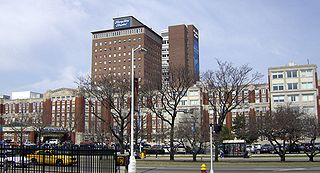
Henry Ford Hospital (HFH) is an 877-bed tertiary care hospital, education and research complex at the western edge of the New Center area in Detroit, Michigan. The flagship facility for the Henry Ford Health System, it was one of the first hospitals in the United States to use a standard fee schedule and favor private or semi-private rooms over large wards. It was the first hospital in the country to form a closed, salaried medical staff. As founder Henry Ford viewed tobacco as being unhealthy, the hospital was one of the first in the United States to institute a total ban on smoking. Henry Ford Hospital is staffed by the Henry Ford Medical Group, one of the nation's largest and oldest group practices with 1,200 physicians in more than 40 specialties.
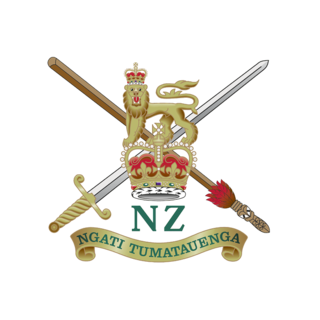
The Royal New Zealand Army Medical Corps (RNZAMC) is a corps of the New Zealand Army, the land branch of the New Zealand Defence Force (NZDF). The Medical Corps provides for the medical needs of soldiers, such as diagnosing and treating diseases and injuries. Medical personnel are part of almost all Army exercises and operations, and personnel work in conjunction with personnel from the Royal New Zealand Dental Corps and the Royal New Zealand Nursing Corps.
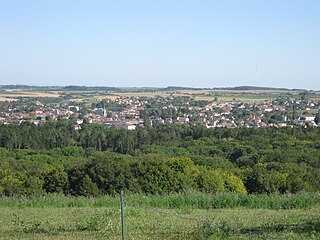
Vittel is a commune in the Vosges department in Grand Est in northeastern France.
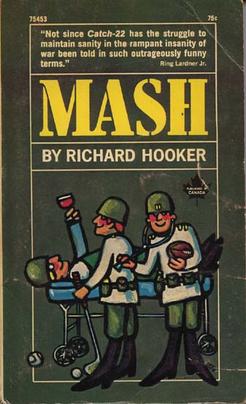
MASH: A Novel About Three Army Doctors is a 1968 novel written by Richard Hooker with the assistance of writer W.C. Heinz. It is notable as the foundation of the M*A*S*H franchise, which includes a 1970 feature film and a long-running TV series (1972–1983). The novel is about a fictional U.S. Mobile Army Surgical Hospital in Korea during the Korean War.

The 38th Battalion, CEF was a unit of the First World War Canadian Expeditionary Force. It was mobilized in Ottawa and recruited in Ottawa, Brockville, Perth, Prescott and Alexandria. An initial draft of five officers and 251 other ranks was sent to England on 24 June 1915. The battalion embarked at Montreal on 1 August 1915, aboard the Caledonian, disembarking in Bermuda on 12 August 1915. Its strength was 35 officers and 959 other ranks. The battalion embarked at Bermuda on 30 May 1916, aboard the Grampian, disembarking in England on 9 June 1916. Its strength was 35 officers and 1001 other ranks. The battalion arrived in France on 13 August 1916, becoming part of the 4th Canadian Division, 12th Canadian Infantry Brigade. It was later reinforced by the 7th Canadian Reserve Battalion. The battalion returned to England on 6 May 1919, arrived in Canada on 13 June 1919, was demobilized in Ottawa on 15 June 1919, and was disbanded by General Order 149 of 15 September 1920.
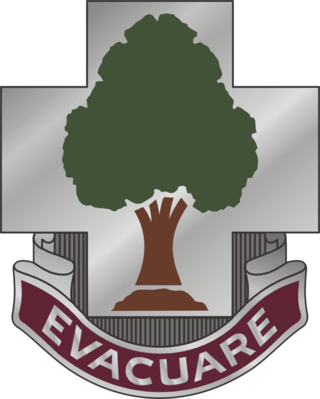
The 115th Field Hospital is a field hospital of the United States Army formed in 1917 and perpetuated until today. The hospital has participated in World War I, World War II, Desert Storm, Operation Iraqi Freedom and Operation Enduring Freedom (Afghanistan). As of March 2019, the 115th Combat Support Hospital reorganized and re-designated as a field hospital and is now a component unit of the 32d Hospital Center.

Harper University Hospital is one of eight hospitals and institutes that compose the Detroit Medical Center. Harper offers services in a broad range of clinical areas, including cardiology, neurology, neurosurgery, organ transplant, plastic surgery, general surgery, bariatric endocrinology and sleep disorders.

75th Division was an infantry division of the British Army in World War I. It was raised in the field by the Egyptian Expeditionary Force (EEF) in 1917 and it included British, Indian and South African troops. It served in the Middle East during the Sinai and Palestine Campaign being involved in the Battles of Megiddo.
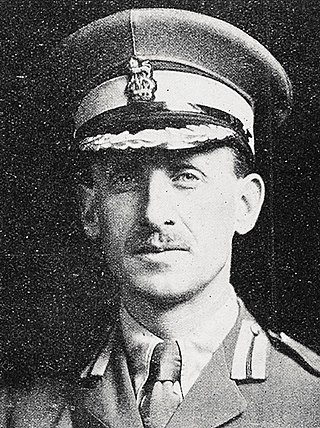
Henry Percy Pickerill (1879–1956) was a British-born New Zealand dental surgeon and researcher, university administrator and plastic surgeon. Pickerill made major contributions to several fields of dentistry and plastic surgery both in New Zealand and overseas.

The 339th Infantry Regiment is an infantry regiment of the United States Army, raised for service in World War I, that served in the North Russia Intervention and World War II.

Sir James Berry FRCS FSA was a Canadian-born British surgeon.

Base Hospital No. 20, located in Châtel-Guyon, France, was one of the hundreds of Base Hospitals created to treat soldiers wounded during the First World War. It was created in 1916 by the University of Pennsylvania and served the American Expeditionary Forces (A.E.F.) until 1919.

Base Hospital No. 5 was organized by Harvard University and was one of six American Expeditionary Forces (AEF) Base Hospitals loaned to the British Expeditionary Forces (BEF) during the First World War. The personnel started in Camiers at General Hospital No. 11 in June 1917 and then moved to General Hospital No. 13, at Boulogne-sur-Mer to finish out the war.

American Base Hospital No. 57 was an American military hospital formed in Georgia, United States. During the First World War the hospital moved to Paris, where a 1,800-bed hospital was set up to deal with war casualties.

American Base Hospital No. 1 was an American military hospital formed in Bellevue Hospital, New York City, United States. During the First World War the hospital moved to Vichy, France where it was set up to deal with war casualties.
American Base Hospital No. 238 was an American military hospital formed in Rimaucourt, Department Haute Marne, France. This was the last hospital to be created during the First World War.
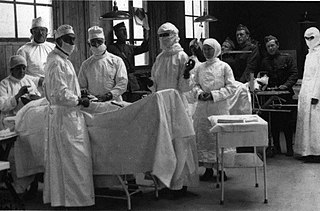
American Base Hospital No. 116 was an American military hospital formed in New York City, United States. During the First World War the hospital moved to Bazoilles-sur-Meuse, Department Vosges, in the advance section, France where it was set up to deal with war casualties.
{{cite book}}: CS1 maint: location missing publisher (link)